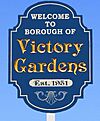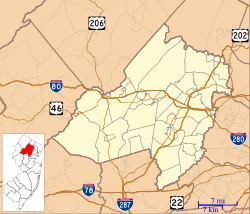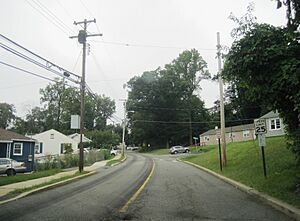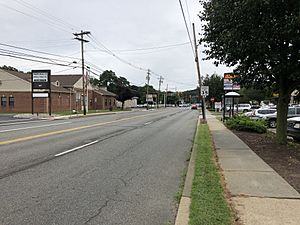Victory Gardens, New Jersey facts for kids
Quick facts for kids
Victory Gardens, New Jersey
|
||
|---|---|---|
|
Borough
|
||

Victory Gardens Municipal Building
|
||
|
||
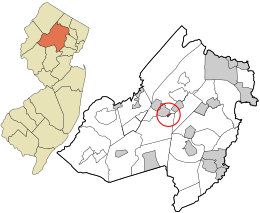
Location in Morris County and the state of New Jersey.
|
||
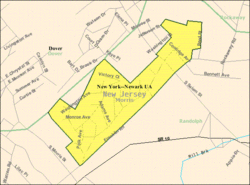
Census Bureau map of Victory Gardens, New Jersey
|
||
| Country | ||
| State | ||
| County | ||
| Incorporated | September 18, 1951 | |
| Government | ||
| • Type | Borough | |
| • Body | Borough Council | |
| Area | ||
| • Total | 0.14 sq mi (0.38 km2) | |
| • Land | 0.14 sq mi (0.38 km2) | |
| • Water | 0.00 sq mi (0.00 km2) 0.00% | |
| Area rank | 562nd of 565 in state 39th of 39 in county |
|
| Elevation | 646 ft (197 m) | |
| Population
(2020)
|
||
| • Total | 1,582 | |
| • Estimate
(2023)
|
1,583 | |
| • Rank | 508th of 565 in state 39th of 39 in county |
|
| • Density | 10,901.3/sq mi (4,209.0/km2) | |
| • Density rank | 34th of 565 in state 1st of 39 in county |
|
| Time zone | UTC−05:00 (Eastern (EST)) | |
| • Summer (DST) | UTC−04:00 (Eastern (EDT)) | |
| ZIP Code |
07801 – Dover
|
|
| Area code(s) | 862/973 and 908 | |
| FIPS code | 3402775890 | |
| GNIS feature ID | 0885427 | |
| Website | ||
Victory Gardens is a small town, called a borough, located in Morris County, New Jersey. In 2020, about 1,582 people lived here. This was a small increase from 2010.
Victory Gardens is the smallest town in Morris County. It is the smallest both in land size and in how many people live there. It is also the most crowded town in the county. In fact, it is the fourth smallest town in all of New Jersey by area.
Contents
History of Victory Gardens
How the Borough Began
Victory Gardens started in 1941 during World War II. The government bought land to build homes for people working in war factories. The town got its name from "victory gardens." These were gardens people planted at home to grow extra food during the war. Many streets in Victory Gardens are named after U.S. Presidents.
Becoming an Independent Town
In 1951, people in Randolph Township voted on whether Victory Gardens should become its own town. Residents in other parts of Randolph Township had some concerns. They felt the money from the government for students living in Victory Gardens did not cover school costs. They also thought the homes in Victory Gardens did not follow the township's building rules.
On September 18, 1951, people voted to make Victory Gardens a separate borough. The New Jersey Legislature officially made it a borough on June 20, 1951. This meant it became its own independent town.
A Special Civil Defense Drill
On November 16, 1958, Victory Gardens made news for a special event. Most of the families in town, 262 out of 297, took part in a "civil defense exercise." This was like a practice drill to prepare for emergencies. Some residents pretended to be "refugees," while others helped out. School boys used Geiger counters, and volunteers helped with medical teams and food. People who stayed home had their movements limited by guards. This showed how the community worked together.
New Homes for the Town
In 1973, a new building project was approved. It added 184 garden apartments to the town. These new homes provided permanent places to live for about 400 people. This was important because the first homes built in the 1940s were only meant to be temporary.
Geography of Victory Gardens
Victory Gardens is a very small town. It covers about 0.15 square miles (0.38 square kilometers) of land. There is no water area within the borough.
The borough shares its borders with two other towns in Morris County. These towns are Dover and Randolph.
Population and People
| Historical population | |||
|---|---|---|---|
| Census | Pop. | %± | |
| 1960 | 1,085 | — | |
| 1970 | 1,027 | −5.3% | |
| 1980 | 1,043 | 1.6% | |
| 1990 | 1,314 | 26.0% | |
| 2000 | 1,546 | 17.7% | |
| 2010 | 1,649 | 6.7% | |
| 2020 | 1,582 | −4.1% | |
| 2023 (est.) | 1,583 | −4.0% | |
| Population sources:1960–1990 2000 2010 2020 |
|||
Population in 2010
In 2010, the town had 1,520 people living in 533 homes. The population density was about 10,419 people per square mile. Most residents were White (58.49%), with a significant number of Black or African American (16.25%) and Asian (2.43%) residents. Many people in Victory Gardens were also of Hispanic or Latino background (62.96%).
About 26.4% of the people were under 18 years old. The average age in the borough was 33.3 years.
Education in Victory Gardens
Victory Gardens does not have its own schools. All public school students from kindergarten through twelfth grade go to schools in the Dover School District. This arrangement has been in place since 2010.
The Dover School District has five schools. In the 2021–22 school year, about 3,448 students were enrolled. The schools include:
- Academy Street Elementary School (grades K-6)
- East Dover Elementary School (grades K-6)
- North Dover Elementary School (grades PreK-6)
- Dover Middle School (grades 7-8)
- Dover High School (grades 9-12)
Students from Mine Hill Township also attend Dover Middle School and Dover High School. Dover High School received a special award in 2013 called the National Blue Ribbon School Award.
Getting Around Victory Gardens
Roads and Highways
As of 2010, Victory Gardens had about 2.89 miles of roads. Most of these roads are taken care of by the town itself. A small part is maintained by Morris County.
County Route 665, also known as South Salem Street, passes through the northwest part of the borough. It connects Victory Gardens to Randolph on both sides.
Public Transportation
NJ Transit offers local bus service in Victory Gardens. You can use the 875 bus route to travel around.
See also
 In Spanish: Victory Gardens para niños
In Spanish: Victory Gardens para niños


